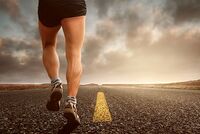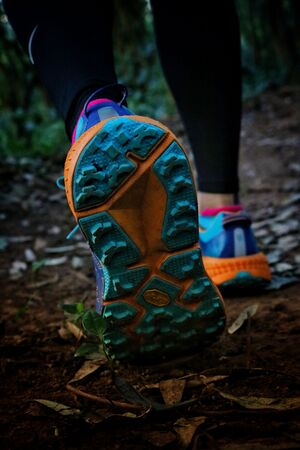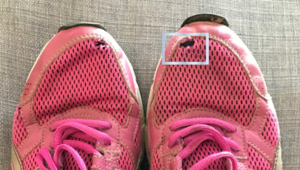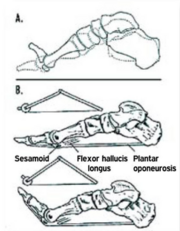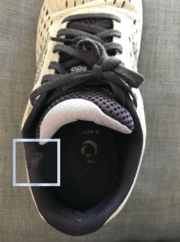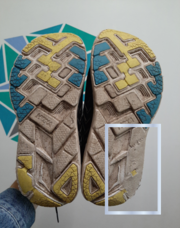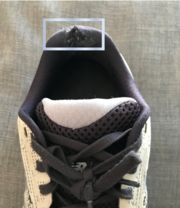Shoe Analysis - Fitting a Shoe: Difference between revisions
(added short introduction and reference) |
No edit summary |
||
| (46 intermediate revisions by 4 users not shown) | |||
| Line 1: | Line 1: | ||
<div class="editorbox"> | <div class="editorbox"> '''Original Editor '''- [[User:Wanda van Niekerk|Wanda van Niekerk]] based on the course by [https://members.physio-pedia.com/course_tutor/dawn-nunes/ Dawn Nunes]<br> | ||
'''Original Editor '''- [[User: | '''Top Contributors''' - {{Special:Contributors/{{FULLPAGENAME}}}}</div> | ||
== Introduction == | == Introduction == | ||
Running for health | [[File:Runner surface and shoes.jpg|thumb|200x200px|alt=]] | ||
Running for health has led to a growing running shoe market worldwide. Over the past 50 years running shoe designs have changed significantly. The purchase of a running shoe can be overwhelming for a runner as the market is full of shoes of different weights, designs, features, materials and prices. Often the consumer is dependent on the advice of a salesperson to select the correct shoe. The challenge for clinicians treating runners is to stay informed about the continuous changes and updates in footwear, as well as the forever changing scientific landscape of shoe benefits and risks to help runners make informed decisions.<ref name=":2">Vincent HK, Vincent KR. Considerations in the Selection of a Running Shoe. In Clinical Care of the Runner 2020 Jan 1 (pp. 95-99). Elsevier.</ref> | |||
Shoe Analysis | == Finding the Right Fit == | ||
[[File:Running shoe.jpg|thumb]] | |||
Physiotherapists working with runners need to be knowledgeable about running shoes. They also need to be accurate and thorough when fitting running shoes. Furthermore, it is important to provide runners with sound advice about their running shoes.<ref name=":0">Nunes, D. Shoe Analysis - Finding the Right Fit Course. Plus. 2021</ref> For a quick review, read this page: [[Shoe Analysis - Basic Anatomy of a Running Shoe|Basic Anatomy of a Running Shoe]] | |||
Physiotherapists can provide advice on shoes based on<ref name=":0" />: | |||
* The foot size of the runner | |||
* What distance do they run/ mileage? | |||
* Running mechanics | |||
* History of previous injuries or current injuries | |||
The | The goal is to be able to guide runners to a type of shoe that suits their abilities and needs.<ref name=":0" /> To be able to do that, it is important to: | ||
* Understand your runner | |||
** Read more: [[An Introduction to Understanding Your Runner]] | |||
* Be aware of the aims of the runner | |||
** Read more: [[Subjective Assessment of a Runner]] | |||
* Know the current running trends of the runner, as well as their running aspirations or goals | |||
It is important to determine if<ref name=":0" />: | |||
* The runner needs one pair of shoes that can be versatile | |||
** e.g. running on road and trail | |||
* Different shoes are necessary | |||
* The shoe selection may change over time as the runner's aims and goals change, for example: | |||
** Beginner runner wanting to do longer distances | |||
** Road runner wanting to do more trail running | |||
** Trail runner wanting to run on more challenging and technical trails | |||
Understanding your runner and their goals are important if you are to provide advice on shoe selection. The subjective and objective assessment of the runner is important and valuable as this determines factors that will impact shoe selection. These factors can include<ref name=":0" />: | |||
* Type of running (road; trail; track) | |||
* Running distance/mileage | |||
* Running terrain | |||
* Runner’s aims | |||
* Preferences for multi-terrain shoe vs road running shoe vs trail shoe vs track shoe | |||
== Assessment of a Runner’s Shoes == | |||
* Ask the runner to bring their old and worn running shoes to the physiotherapy consultation/session | |||
* Assess all the different parts of the shoe - [[Shoe Analysis - Basic Anatomy of a Running Shoe|Basic Anatomy of a Running Shoe]] | |||
* It is always better to analyse a runner’s older shoes than brand new ones | |||
=== Common Issues in Running Shoes That Are Not Always the Product's Fault === | |||
[[File:Running shoe Toe lift.png|thumb|Running shoe upper - Toe lift]] | |||
Grant Bryant from the Run Store published this blog: [https://www.runstore.co.za/its-not-always-a-shoe-fault/ It's Not Always a Shoe Fault] and highlights some common issues found in running shoes that are not always due to the product. Issues to be aware of include<ref name=":1">Bryant G. It's Not Always a Shoe Fault.[Internet]. 2020 [cited 07 December 2021]. Available from: https://www.runstore.co.za/its-not-always-a-shoe-fault/</ref>: | |||
* Toe lift | |||
** Running shoe upper with holes near the big toe | |||
** Contributing factors: | |||
***[[File:Windlass Test.png|thumb|231x231px|alt=|Windlass Mechanism]][[Windlass Test|Windlass mechanism]] of the foot<ref>Welte L, Kelly LA, Kessler SE, Lieberman DE, D'Andrea SE, Lichtwark GA, Rainbow MJ. The extensibility of the plantar fascia influences the windlass mechanism during human running. Proceedings of the Royal Society B. 2021 Jan 27;288(1943):20202095.</ref> – tightness of the plantar fascia (and possibly [[Achilles Tendinopathy|Achilles]] tendon and calf muscles) causes the big toe to lift and, thus, make contact with the upper of the shoe. | |||
*** Shape of shoe | |||
*** Volume of upper around the toe box | |||
*** Flexibility of the shoe | |||
*** Combination of shoe materials | |||
** Ankle and foot mobilisation, myofascial release of the plantar fascia and surrounding areas could reduce toe lift incidences | |||
{{#ev:youtube|watch?v=_UVbR7uD0Og}}<ref>Docpods. Windlass mechanism and how it relates to foot pain and heel pain. Available fromhttps://www.youtube.com/watch?v=_UVbR7uD0Og (last accessed 7 December 2021) </ref> | |||
* [[File:Running shoe Heel collar scuffing.png|thumb|242x242px|Heel collar scuffing|alt=]]Heel Collar Scuffing | |||
** Contributing factors: | |||
*** Shoelaces not tied correctly | |||
**** Review lacing techniques here: [https://www.physio-pedia.com/Shoe_Analysis_-_Basic_Anatomy_of_a_Running_Shoe?utm_source=physiopedia&utm_medium=search&utm_campaign=ongoing_internal#Different_Parts_of_the_Shoe Lacing Techniques] | |||
*** Narrow base of running gait due to weakness or lack of range of motion in hips and glutes – this means that the opposite foot may strike the upper collar causing excessive wearing. Shoelaces that are not tied properly can compound this issue as the collar will be more open and exposed. | |||
*** Runners with low flat arches or wider feet may also experience this scuffing around the heel collar. | |||
* Splitting sides | |||
** Contributing factors: | |||
*** Shoe too wide | |||
*** Shoe too narrow | |||
*** Incorrect shoe type, for example, neutral runner running in a stability shoe | |||
*** Lack of cleaning or incorrect cleaning of shoes – especially trail shoes (dirt between mesh layers can act like sandpaper and damage the upper of the shoe) | |||
*[[File:Running shoe heel drag image.png|thumb|228x228px|Signs of heel drag on sole of left shoe]]Heel drag | |||
** Excessive wear will be visible on the outside of the heel of the shoe's sole | |||
** This is often caused by the gluteal muscles not firing properly, leg length discrepancies, pelvic tilt or scoliosis | |||
** The image on the right shows signs of heel drag on the left shoe of a runner who had a hamstring injury | |||
*** | |||
* [[File:Running shoe internal heel wear.png|thumb|208x208px|Inner heel wear]]Internal heel wear | |||
** Contributing factors: | |||
*** Shoelaces not tied correctly | |||
*** Runner with a Haglund’s deformity | |||
*** Shape of the conforming heel cup to the shape of the heel – if this does not match excessive wear is possible | |||
* Toe bumper coming loose | |||
** Contributing factors: | |||
*** Incorrect shoe care (washing machine, tumble dryer) | |||
*** Stress or trauma to the area – trail running in tricky terrain | |||
==== Washing and Maintaining Shoes ==== | |||
* [[File:Running shoe toe bumper loose.png|thumb|180x180px|Toe bumper of shoe coming loose]]Never wash shoes in a washing machine | |||
* Never artificially dry shoes | |||
* Do not leave shoes in the car in the heat – this softens the foam and influences the life span of the shoe<ref name=":1" /> | |||
* Do not leave shoes in the sun to dry | |||
* Be careful with common cleaning solvents | |||
=== Assessing a Runner’s Shoe === | |||
Some factors to consider with a runner's shoes at the assessment<ref name=":0" />: | |||
* Shoe mileage (how many kilometres has the runner run in the shoes) | |||
* The type of shoe (road running; trail running; neutral shoe; stability shoe) | |||
* Consider the [https://www.physio-pedia.com/Shoe_Analysis_-_Basic_Anatomy_of_a_Running_Shoe?utm_source=physiopedia&utm_medium=search&utm_campaign=ongoing_internal#Important_Aspects_in_Selecting_Running_Shoes cushioning/stack height] and [https://www.physio-pedia.com/Shoe_Analysis_-_Basic_Anatomy_of_a_Running_Shoe?utm_source=physiopedia&utm_medium=search&utm_campaign=ongoing_internal#Important_Aspects_in_Selecting_Running_Shoes heel to toe drop] of the shoe | |||
* Apps are available that can provide relevant information on the specific shoe such as the stack height and heel to toe drop (e.g. [https://runrepeat.com/ RunRepeat]) | |||
When assessing the runner's shoe, focus on the following<ref name=":0" />: | |||
* Assess the wear on the shoe | |||
* Always compare left to right | |||
* Be methodical i.e. start from the front, laces, different angles, side view and back view | |||
* Assess the wear on the upper and sole of the shoe | |||
* Older more worn running shoes will provide more information | |||
== Running Shoes for Specific Injuries == | |||
Keep in mind that the individual response to different shoes remains variable and unpredictable. Furthermore, the evidence is lacking on injured runners and the selection of shoes for specific injuries. Remember that shoe selection is just a part of your management plan and that educating the runner about their injury, load management, training at the appropriate level and exercise prescription to address any possible deficits such as strength or control remains crucial.<ref>Running Physio. Shoe Selection [Internet]. 2021 [accessed 7 December 2021]. Available from https://www.running-physio.com/category/shoe-selection/</ref> | |||
{{#ev:youtube|watch?v=HjVDLXKYqqw&t=195s}}<ref>Running Physio. How to select running shoes for specific injuries. Available from https://www.youtube.com/watch?v=HjVDLXKYqqw&t=195s (last accessed 7 December 2021) </ref> | |||
=== Case Studies and Shoe Selection === | |||
'''Achilles Tendinopathy''' | |||
* Case study<ref name=":0" />: | |||
** Runner recovering from [[Achilles Tendinopathy|Achilles tendinopathy]] | |||
** Gradually returning to running and wanting to increase mileage | |||
* Advice on shoe selection<ref name=":0" />: | |||
** Assess the area of pain on Achilles Tendon - sometimes the pressure from the heel collar irritates the tendon | |||
** Consider reducing the load and stretch on the Achilles tendon by suggesting a running shoe with a higher heel to toe drop and with more cushioning | |||
** A shoe with a higher heel to toe drop may be favourable for management of injuries such as Achilles tendinopathy as the maximum range of ankle dorsiflexion is decreased. The muscle-tendon unit length of the gastrocnemius is also reduced. One systematic review by Rabusin et al.<ref name=":3" /> reported that heel lifts can affect these specific biomechanical parameters.<ref name=":3">Rabusin CL, Menz HB, McClelland JA, Tan JM, Whittaker GA, Evans AM, Munteanu SE. Effects of heel lifts on lower limb biomechanics and muscle function: a systematic review. Gait & posture. 2019 Mar 1;69:224-34.</ref>A randomised trial investigated the efficacy of heel lifts versus calf muscle eccentric exercise for mid-portion Achilles tendinopathy and found that heel lifts were more effective than calf muscle eccentric exercise in reducing pain.<ref name=":4">Rabusin CL, Menz HB, McClelland JA, Evans AM, Malliaras P, Docking SI, Landorf KB, Gerrard JM, Munteanu SE. Efficacy of heel lifts versus calf muscle eccentric exercise for mid-portion Achilles tendinopathy (HEALTHY): a randomised trial. British journal of sports medicine. 2021 May 1;55(9):486-92.</ref> Furthermore there was an improvement in function at 12 weeks.<ref name=":4" /> However, further research is necessary to determine if these differences are clinically relevant, but is is noted that clinicians can consider the use of heel lifts as a first line treatment for adults with mid-portion Achilles tendinopathy.<ref name=":4" /> | |||
'''Medial Tibial Stress Syndrome''' | |||
* Case study<ref name=":0" />: | |||
** Road runner with [[Medial Tibial Stress Syndrome|medial tibial stress syndrome]] | |||
** Returning to running gradually with specific rehabilitation exercises and load management advice | |||
* Advice on shoe selection<ref name=":0" />: | |||
** Shoe with more cushioning / stack height | |||
** Correct lacing techniques | |||
** Impact injury - can recommend to runner to start training on a firm grass field, to reduce impact | |||
** A shoe with adequate cushioning may absorb the impact of the foot hitting the ground when running | |||
** A recent systematic review concluded that shoes with low levels of cushioning can increase the risk of shin and calf injuries<ref>Sun X, Lam WK, Zhang X, Wang J, Fu W. [https://www.ncbi.nlm.nih.gov/pmc/articles/PMC7039038/ Systematic review of the role of footwear constructions in running biomechanics: implications for running-related injury and performance.] Journal of sports science & medicine. 2020 Mar;19(1):20.</ref> | |||
'''Metatarsalgia''' | |||
*[[Metatarsalgia]] is a general term for [[Pain Behaviours|pain]] in the area of the metatarsophalangeal joints. Pain on the ball of the foot. | |||
* Case study<ref name=":0" />: | |||
** Runner with metatarsalgia , uncomfortable and flaring up when running | |||
* Advice on shoe selection<ref name=":0" />: | |||
** Investigate the toe box of the shoe - is it too narrow, causing compression? | |||
** Restriction of the natural foot deformation and mid-forefoot widening has been shown to influence the load distribution and forces in the foot and can cause running-related repetitive loading disorders such as metatarsalgia, interdigital neuromas, bunions and painful toenails. <ref name=":2" /> | |||
** Advice on lacing techniques | |||
'''Tibialis Anterior/ Anterior Biomechanical Overload Syndrome''' | |||
* Case study<ref name=":0" />: | |||
** Runner with acute [[Tibialis Anterior|tibialis anterior]] pain | |||
** Pain developed shortly after a change in running shoes | |||
** Feels as if there is no power to lift foot while running | |||
* Advice on shoe selection: | |||
** Assess the weight of the shoe and if there is a difference between current and previous running shoes | |||
** The activation of tibialis anterior is affected by the mass of a shoe in runners and heavy running shoes used for running over a period of time may cause injury related to tibialis anterior muscle fatigue<ref>Wang IL, Graham RB, Bourdon EJ, Chen YM, Gu CY, Wang LI. [https://www.ncbi.nlm.nih.gov/pmc/articles/PMC7039018/ Biomechanical analysis of running foot strike in shoes of different mass]. Journal of sports science & medicine. 2020 Mar;19(1):130.</ref> | |||
'''Note:''' Runners can develop chronic exertional compartment syndrome in all of the compartments of the lower leg. Specifically in the anterior compartment of the lower leg, the following structures may be involved: tibialis anterior, extensor digitorum longus, extensor hallucis longus, peroneus tertius, deep peroneal nerve, and the anterior tibial artery and vein. The runner may report a dull, achy, cramping pain or feeling in the involved limb and may be accompanied by numbness, paresthesia and/or muscle weakness. These symptoms often worsen as the intensity and/or duration of the activity increases. Symptoms usually subside 15 to 20 minutes after the activity has stopped.<ref>Vajapey S, Miller TL. Evaluation, diagnosis, and treatment of chronic exertional compartment syndrome: a review of current literature. The Physician and sportsmedicine. 2017 Oct 2;45(4):391-8.</ref> | |||
Acute compartment syndrome occurs when an injury to a limb is a result of a significant increase in intracompartmental pressure. This increase in pressure results in decreased perfusion pressure, subsequent ischaemia to muscles and nerves and this may result in tissue necrosis and complications. In acute compartment syndrome, pain is typically out of proportion to the examination. Other symptoms that can arise as the intracompartmental pressure increases are the 6 "Ps" (passive pain (disproportionate to the injury), paresthesia, pallor, paralysis, pulselessness and poikilothermia (difference in temperature between limbs, the involved or affected limb is usually cooler than the other side).<ref>Farah O, Farah G, Mumuni S, Volchenko E, Hutchinson MR. Acute Compartment Syndrome in the Athlete. Clinics in Sports Medicine. 2023 Apr 6.</ref> | |||
Clinicians should be aware of the differences between chronic exertional compartment syndrome and acute compartment syndrome as the latter requires emergent and invasive treatment. | |||
=== Changing Shoes === | |||
* If a runner has a specific brand of shoe that is working well - don't change it | |||
* Try and adapt to a similar shoe within the same brand | |||
* If a drastic change is needed - introduce the change gradually<ref name=":0" /> | |||
== References == | == References == | ||
<references /> | <references /> | ||
[[Category:Course Pages]] | |||
[[Category:Plus Content]] | |||
[[Category:Running]] | |||
Latest revision as of 01:53, 25 June 2023
Top Contributors - Wanda van Niekerk, Kim Jackson, Jess Bell and Tarina van der Stockt
Introduction[edit | edit source]
Running for health has led to a growing running shoe market worldwide. Over the past 50 years running shoe designs have changed significantly. The purchase of a running shoe can be overwhelming for a runner as the market is full of shoes of different weights, designs, features, materials and prices. Often the consumer is dependent on the advice of a salesperson to select the correct shoe. The challenge for clinicians treating runners is to stay informed about the continuous changes and updates in footwear, as well as the forever changing scientific landscape of shoe benefits and risks to help runners make informed decisions.[1]
Finding the Right Fit[edit | edit source]
Physiotherapists working with runners need to be knowledgeable about running shoes. They also need to be accurate and thorough when fitting running shoes. Furthermore, it is important to provide runners with sound advice about their running shoes.[2] For a quick review, read this page: Basic Anatomy of a Running Shoe
Physiotherapists can provide advice on shoes based on[2]:
- The foot size of the runner
- What distance do they run/ mileage?
- Running mechanics
- History of previous injuries or current injuries
The goal is to be able to guide runners to a type of shoe that suits their abilities and needs.[2] To be able to do that, it is important to:
- Understand your runner
- Read more: An Introduction to Understanding Your Runner
- Be aware of the aims of the runner
- Read more: Subjective Assessment of a Runner
- Know the current running trends of the runner, as well as their running aspirations or goals
It is important to determine if[2]:
- The runner needs one pair of shoes that can be versatile
- e.g. running on road and trail
- Different shoes are necessary
- The shoe selection may change over time as the runner's aims and goals change, for example:
- Beginner runner wanting to do longer distances
- Road runner wanting to do more trail running
- Trail runner wanting to run on more challenging and technical trails
Understanding your runner and their goals are important if you are to provide advice on shoe selection. The subjective and objective assessment of the runner is important and valuable as this determines factors that will impact shoe selection. These factors can include[2]:
- Type of running (road; trail; track)
- Running distance/mileage
- Running terrain
- Runner’s aims
- Preferences for multi-terrain shoe vs road running shoe vs trail shoe vs track shoe
Assessment of a Runner’s Shoes[edit | edit source]
- Ask the runner to bring their old and worn running shoes to the physiotherapy consultation/session
- Assess all the different parts of the shoe - Basic Anatomy of a Running Shoe
- It is always better to analyse a runner’s older shoes than brand new ones
Common Issues in Running Shoes That Are Not Always the Product's Fault[edit | edit source]
Grant Bryant from the Run Store published this blog: It's Not Always a Shoe Fault and highlights some common issues found in running shoes that are not always due to the product. Issues to be aware of include[3]:
- Toe lift
- Running shoe upper with holes near the big toe
- Contributing factors:
- Windlass mechanism of the foot[4] – tightness of the plantar fascia (and possibly Achilles tendon and calf muscles) causes the big toe to lift and, thus, make contact with the upper of the shoe.
- Shape of shoe
- Volume of upper around the toe box
- Flexibility of the shoe
- Combination of shoe materials
- Ankle and foot mobilisation, myofascial release of the plantar fascia and surrounding areas could reduce toe lift incidences
- Heel Collar Scuffing
- Contributing factors:
- Shoelaces not tied correctly
- Review lacing techniques here: Lacing Techniques
- Narrow base of running gait due to weakness or lack of range of motion in hips and glutes – this means that the opposite foot may strike the upper collar causing excessive wearing. Shoelaces that are not tied properly can compound this issue as the collar will be more open and exposed.
- Runners with low flat arches or wider feet may also experience this scuffing around the heel collar.
- Shoelaces not tied correctly
- Contributing factors:
- Splitting sides
- Contributing factors:
- Shoe too wide
- Shoe too narrow
- Incorrect shoe type, for example, neutral runner running in a stability shoe
- Lack of cleaning or incorrect cleaning of shoes – especially trail shoes (dirt between mesh layers can act like sandpaper and damage the upper of the shoe)
- Contributing factors:
- Heel drag
- Excessive wear will be visible on the outside of the heel of the shoe's sole
- This is often caused by the gluteal muscles not firing properly, leg length discrepancies, pelvic tilt or scoliosis
- The image on the right shows signs of heel drag on the left shoe of a runner who had a hamstring injury
- Internal heel wear
- Contributing factors:
- Shoelaces not tied correctly
- Runner with a Haglund’s deformity
- Shape of the conforming heel cup to the shape of the heel – if this does not match excessive wear is possible
- Contributing factors:
- Toe bumper coming loose
- Contributing factors:
- Incorrect shoe care (washing machine, tumble dryer)
- Stress or trauma to the area – trail running in tricky terrain
- Contributing factors:
Washing and Maintaining Shoes[edit | edit source]
- Never wash shoes in a washing machine
- Never artificially dry shoes
- Do not leave shoes in the car in the heat – this softens the foam and influences the life span of the shoe[3]
- Do not leave shoes in the sun to dry
- Be careful with common cleaning solvents
Assessing a Runner’s Shoe[edit | edit source]
Some factors to consider with a runner's shoes at the assessment[2]:
- Shoe mileage (how many kilometres has the runner run in the shoes)
- The type of shoe (road running; trail running; neutral shoe; stability shoe)
- Consider the cushioning/stack height and heel to toe drop of the shoe
- Apps are available that can provide relevant information on the specific shoe such as the stack height and heel to toe drop (e.g. RunRepeat)
When assessing the runner's shoe, focus on the following[2]:
- Assess the wear on the shoe
- Always compare left to right
- Be methodical i.e. start from the front, laces, different angles, side view and back view
- Assess the wear on the upper and sole of the shoe
- Older more worn running shoes will provide more information
Running Shoes for Specific Injuries[edit | edit source]
Keep in mind that the individual response to different shoes remains variable and unpredictable. Furthermore, the evidence is lacking on injured runners and the selection of shoes for specific injuries. Remember that shoe selection is just a part of your management plan and that educating the runner about their injury, load management, training at the appropriate level and exercise prescription to address any possible deficits such as strength or control remains crucial.[6]
Case Studies and Shoe Selection[edit | edit source]
Achilles Tendinopathy
- Case study[2]:
- Runner recovering from Achilles tendinopathy
- Gradually returning to running and wanting to increase mileage
- Advice on shoe selection[2]:
- Assess the area of pain on Achilles Tendon - sometimes the pressure from the heel collar irritates the tendon
- Consider reducing the load and stretch on the Achilles tendon by suggesting a running shoe with a higher heel to toe drop and with more cushioning
- A shoe with a higher heel to toe drop may be favourable for management of injuries such as Achilles tendinopathy as the maximum range of ankle dorsiflexion is decreased. The muscle-tendon unit length of the gastrocnemius is also reduced. One systematic review by Rabusin et al.[8] reported that heel lifts can affect these specific biomechanical parameters.[8]A randomised trial investigated the efficacy of heel lifts versus calf muscle eccentric exercise for mid-portion Achilles tendinopathy and found that heel lifts were more effective than calf muscle eccentric exercise in reducing pain.[9] Furthermore there was an improvement in function at 12 weeks.[9] However, further research is necessary to determine if these differences are clinically relevant, but is is noted that clinicians can consider the use of heel lifts as a first line treatment for adults with mid-portion Achilles tendinopathy.[9]
Medial Tibial Stress Syndrome
- Case study[2]:
- Road runner with medial tibial stress syndrome
- Returning to running gradually with specific rehabilitation exercises and load management advice
- Advice on shoe selection[2]:
- Shoe with more cushioning / stack height
- Correct lacing techniques
- Impact injury - can recommend to runner to start training on a firm grass field, to reduce impact
- A shoe with adequate cushioning may absorb the impact of the foot hitting the ground when running
- A recent systematic review concluded that shoes with low levels of cushioning can increase the risk of shin and calf injuries[10]
Metatarsalgia
- Metatarsalgia is a general term for pain in the area of the metatarsophalangeal joints. Pain on the ball of the foot.
- Case study[2]:
- Runner with metatarsalgia , uncomfortable and flaring up when running
- Advice on shoe selection[2]:
- Investigate the toe box of the shoe - is it too narrow, causing compression?
- Restriction of the natural foot deformation and mid-forefoot widening has been shown to influence the load distribution and forces in the foot and can cause running-related repetitive loading disorders such as metatarsalgia, interdigital neuromas, bunions and painful toenails. [1]
- Advice on lacing techniques
Tibialis Anterior/ Anterior Biomechanical Overload Syndrome
- Case study[2]:
- Runner with acute tibialis anterior pain
- Pain developed shortly after a change in running shoes
- Feels as if there is no power to lift foot while running
- Advice on shoe selection:
- Assess the weight of the shoe and if there is a difference between current and previous running shoes
- The activation of tibialis anterior is affected by the mass of a shoe in runners and heavy running shoes used for running over a period of time may cause injury related to tibialis anterior muscle fatigue[11]
Note: Runners can develop chronic exertional compartment syndrome in all of the compartments of the lower leg. Specifically in the anterior compartment of the lower leg, the following structures may be involved: tibialis anterior, extensor digitorum longus, extensor hallucis longus, peroneus tertius, deep peroneal nerve, and the anterior tibial artery and vein. The runner may report a dull, achy, cramping pain or feeling in the involved limb and may be accompanied by numbness, paresthesia and/or muscle weakness. These symptoms often worsen as the intensity and/or duration of the activity increases. Symptoms usually subside 15 to 20 minutes after the activity has stopped.[12]
Acute compartment syndrome occurs when an injury to a limb is a result of a significant increase in intracompartmental pressure. This increase in pressure results in decreased perfusion pressure, subsequent ischaemia to muscles and nerves and this may result in tissue necrosis and complications. In acute compartment syndrome, pain is typically out of proportion to the examination. Other symptoms that can arise as the intracompartmental pressure increases are the 6 "Ps" (passive pain (disproportionate to the injury), paresthesia, pallor, paralysis, pulselessness and poikilothermia (difference in temperature between limbs, the involved or affected limb is usually cooler than the other side).[13]
Clinicians should be aware of the differences between chronic exertional compartment syndrome and acute compartment syndrome as the latter requires emergent and invasive treatment.
Changing Shoes[edit | edit source]
- If a runner has a specific brand of shoe that is working well - don't change it
- Try and adapt to a similar shoe within the same brand
- If a drastic change is needed - introduce the change gradually[2]
References[edit | edit source]
- ↑ 1.0 1.1 Vincent HK, Vincent KR. Considerations in the Selection of a Running Shoe. In Clinical Care of the Runner 2020 Jan 1 (pp. 95-99). Elsevier.
- ↑ 2.00 2.01 2.02 2.03 2.04 2.05 2.06 2.07 2.08 2.09 2.10 2.11 2.12 2.13 2.14 Nunes, D. Shoe Analysis - Finding the Right Fit Course. Plus. 2021
- ↑ 3.0 3.1 Bryant G. It's Not Always a Shoe Fault.[Internet]. 2020 [cited 07 December 2021]. Available from: https://www.runstore.co.za/its-not-always-a-shoe-fault/
- ↑ Welte L, Kelly LA, Kessler SE, Lieberman DE, D'Andrea SE, Lichtwark GA, Rainbow MJ. The extensibility of the plantar fascia influences the windlass mechanism during human running. Proceedings of the Royal Society B. 2021 Jan 27;288(1943):20202095.
- ↑ Docpods. Windlass mechanism and how it relates to foot pain and heel pain. Available fromhttps://www.youtube.com/watch?v=_UVbR7uD0Og (last accessed 7 December 2021)
- ↑ Running Physio. Shoe Selection [Internet]. 2021 [accessed 7 December 2021]. Available from https://www.running-physio.com/category/shoe-selection/
- ↑ Running Physio. How to select running shoes for specific injuries. Available from https://www.youtube.com/watch?v=HjVDLXKYqqw&t=195s (last accessed 7 December 2021)
- ↑ 8.0 8.1 Rabusin CL, Menz HB, McClelland JA, Tan JM, Whittaker GA, Evans AM, Munteanu SE. Effects of heel lifts on lower limb biomechanics and muscle function: a systematic review. Gait & posture. 2019 Mar 1;69:224-34.
- ↑ 9.0 9.1 9.2 Rabusin CL, Menz HB, McClelland JA, Evans AM, Malliaras P, Docking SI, Landorf KB, Gerrard JM, Munteanu SE. Efficacy of heel lifts versus calf muscle eccentric exercise for mid-portion Achilles tendinopathy (HEALTHY): a randomised trial. British journal of sports medicine. 2021 May 1;55(9):486-92.
- ↑ Sun X, Lam WK, Zhang X, Wang J, Fu W. Systematic review of the role of footwear constructions in running biomechanics: implications for running-related injury and performance. Journal of sports science & medicine. 2020 Mar;19(1):20.
- ↑ Wang IL, Graham RB, Bourdon EJ, Chen YM, Gu CY, Wang LI. Biomechanical analysis of running foot strike in shoes of different mass. Journal of sports science & medicine. 2020 Mar;19(1):130.
- ↑ Vajapey S, Miller TL. Evaluation, diagnosis, and treatment of chronic exertional compartment syndrome: a review of current literature. The Physician and sportsmedicine. 2017 Oct 2;45(4):391-8.
- ↑ Farah O, Farah G, Mumuni S, Volchenko E, Hutchinson MR. Acute Compartment Syndrome in the Athlete. Clinics in Sports Medicine. 2023 Apr 6.
